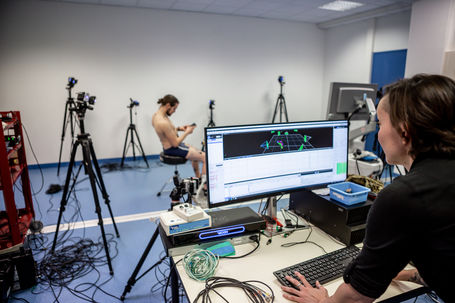🔬 Coming Soon: Unlocking the Secrets of Extreme Drumming Performance
We’ve pushed the boundaries of human movement to answer a thrilling question:
How do metal drummers achieve lightning-fast footwork—up to 10 hits per second per foot—without breaking down?
Our team combined neuroscience, biomechanics, and musical performance to explore how expert drummers use their ankles like finely tuned machines. The findings are astonishing—and they’re almost ready to be revealed.
🧠 Discover how involuntary tremors helped inspire our understanding of intentional, high-speed drumming.
🎵 Learn what separates top performers from the rest.
💥 Understand the risks behind the technique—and how to prevent them.
Stay tuned.

THE PROJECT
DRUMS BIOMECH is a scientific exploration of one of the most extreme forms of human movement: high-speed double bass drumming in metal music. Some drummers can strike the bass drum up to 20 times per second, using only their legs. How is that physically possible? What happens in the body to enable such speed, endurance, and control?
The project had two main goals:
🧠 Scientific
We aimed to understand the neuromuscular and biomechanical mechanisms behind the so-called ankle technique—a foot technique used to reach extremely high movement frequencies. Using motion capture, electromyography (EMG), and reflex measurements, we studied how muscle-tendon systems and spinal reflexes interact to produce oscillatory ankle movements at up to 10 Hz per leg—a level rarely seen in lower-limb activity. Surprisingly, we found strong parallels between this technique and physiological tremors, offering new insights into motor control and the body’s natural resonance capacities.
🛡️ Preventive
At the same time, we investigated the physical strain and injury risks associated with such performance. High-speed repetition demands both speed and stability—particularly from the back, hips, and core muscles. These sustained contractions can lead to fatigue, pain, and long-term musculoskeletal disorders. By identifying the individual adaptations that allow some drummers to play faster, longer, and safer, the project also offers practical recommendations for injury prevention—not only for musicians, but for anyone engaged in repetitive, high-intensity physical activity.
DRUMS BIOMECH bridges science, music, and health. It’s a project for researchers, performers, and anyone fascinated by what the human body can do when pushed to its limits.

RESEARCH AND FINDINGS
Curious about how metal drummers manage to play up to 10 strokes per second per leg?
🎥 We’ve just started sharing short, easy-to-understand video reels on our Instagram to break down the science behind this unique technique !
🧠 If you want to dive deeper, the scientific preprint of our study is now available here:
🔗 biorxiv.org/content/10.1101/2025.06.18.660287v1
📌 Note: This version is written for a scientific audience and has not yet been peer-reviewed—it’s still under revision for publication in an academic journal.
🚀 Whether you're a drummer, a biomechanics nerd, or just curious, we’re excited to help you explore the hidden power—and physical cost—of speed behind the drum kit.
MEDIA & PRESS
FRENCH GRIP CHANNEL (FRENCH)
JAMES PAYNE (ENGLISH)
KRIMH (ENGLISH)
PODCAST LE LABO DES SAVOIRS (FRENCH)
PODCAST A LA BAGUETTE (FRENCH)
ABOUT ME & THE LAB
🎓 Who I Am
Hi, I’m Aurélie Sarcher — a biomechanics researcher, and also a metal drummer.
-
I hold an engineering degree and a PhD in biomechanics.
-
I first worked in Montreal and at the University Hospital of Nantes, focusing on motor function in adults and children with disabilities.
-
Since 2019, I’ve been a research engineer in the Movement - Interactions - Performance (MIP) lab, in the STAPS department of Nantes Université, working on health, movement, and sports performance.
🥁 Music & Motivation
Beyond research, I’ve been playing drums for over 12 years.
-
I currently play in Silent Seas (modern death) and Trollheart (pagan death), both based in Nantes.
-
My personal experience as a drummer inspired me to launch DRUMS BIOMECH — to understand how we play fast, and what it costs our bodies.
🧬 The Research Environment
-
I work at the Movement – Interactions – Performance (MIP) lab at Nantes Université, where we study extreme motor performance across contexts.
-
DRUMS BIOMECH was developed in collaboration with the DRUMMER Lab at the University of Windsor (Canada), led by Dr. Nadia Azar, a specialist in drumming ergonomics.
-
The experimental data were collected at the PEPSE platform, equipped with high-end motion capture and EMG systems.











